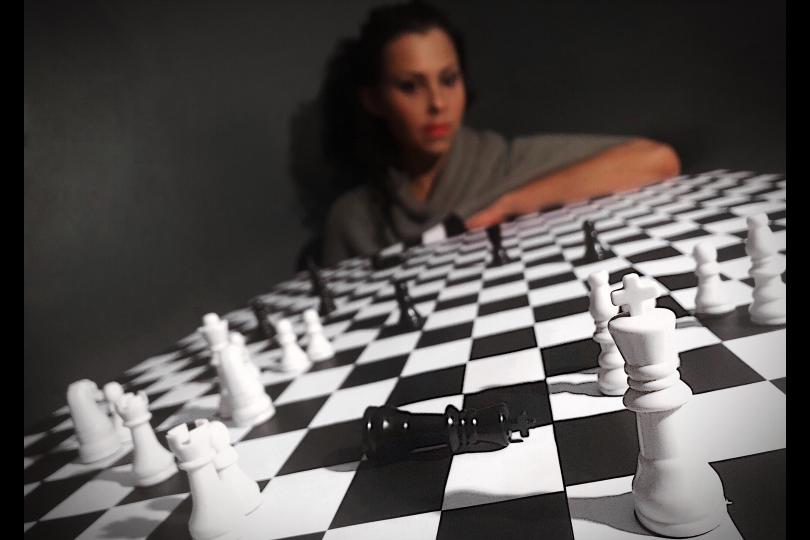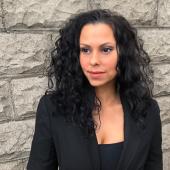The Changing Landscape of American Theater

I’m self-quarantined, sitting at my desk drinking French roast coffee from my Ember mug with my Chihuahua snuggled on my lap in my house in Idaho. Yes, a Puerto Rican in Idaho. And, in the midst of all this comfort and my fortunate good health, I’m worrying that more of my upcoming work in the Twin Cities will be postponed or canceled. I scroll through social media and see other theater people who are also trying to navigate this time of uncertainty.
I read posts on how the hardships affect my elders, those who paved the way for me through the many years of contracted work without health care and sustainable paychecks. I read tweets from people of color about needing to move back home, since they were barely able to make ends meet with the handful of tokenized plays in town before the pandemic. I get a call from a smart and talented young Latina from a prestigious acting program who shares her fears about a future waiting tables while her expensive education affords her roles as the frumpy maid or evil seductress. She asks if she should stick it out or cut her losses during these especially hard times. She asks if this career is worth it. And, I hesitate.
I want to tell this young Latina the truth. I want to tell her what I’ve had to do in order to survive in this brutal industry that I love. I’ve had to master stage management in order to sit next to the men and observe their directing. To learn and work in every facet of theater so that I wouldn’t be told I was not experienced enough. To read the books assigned to kids who had the privilege of attending elite institutions so that I wouldn’t be told I was not smart enough. To self-educate and look up terms the critics use to describe plays, like “Brechtian” or “Grotowski-esque,” or some other European guy’s name-ish. To dress in ways that boxed out my shape and hid my loud Latina hips. To disagree with a smile on my face and speak in a measured cadence so as not to upset the fragility of yet another white boss. To communicate in code with the few other POCs from behind the scenes. To start writing the stories and shaping the narrative as a producer to make space for others since there was no space for me. To train my body to function on four hours of sleep in order to be as efficient as possible right up to the moment of disconnecting with lethal doses of whiskey. To suppress my resentment in having to be an activist first and an artist second. To choose small moments of complacency in order to fight larger injustices. To cut out pieces of myself to triage the rest. But, I hesitate.
Instead, I tell this scared Latina that it will be okay. I tell her this will pass. But what I should have said was, “I too am afraid.” I am afraid we are experiencing the outcome of an antiquated capitalist model. I am afraid that many theaters will not survive this pandemic. That the gap between large-scale and small theaters will widen. That any economic rebound will result in theaters seeing programming and efforts on equity as a novelty. That theaters will continue to hide behind a facade of displayed diversity onstage, use exploitative marketing strategies, and showcase stories that reduce my multilayered and intersectional identity into a national narrative of “Hispanic” and spoon-feed it to all-white audiences. And, I am afraid the greatest threat to theater are the power dynamics already embedded in our industry.
When talking about power dynamics, it’s important to remember that this nation was formed through mass murder, slavery, and rape. That is not to take away from the incredible people who make up this country, but rather, to jog a full memory. The foundation of our nation is an important part of our history that must not be forgotten when discussing the delineation of power. Particular groups of people benefited from this violent start of our nation; they put structures in place that continue to benefit some economically, politically, and socially at the expense of others. This colonial legacy is present at all levels of the theater industry.
According to a report by the Asian American Performers Action Coalition (AAPAC), casting of non-white actors in New York City’s mainstream theaters in 2017 had increased slightly from 29.4% to 33% over the previous three years. However, AAPAC also found that in 2017, 95% of all Broadway plays were written and directed by white individuals.i The Broadway League found that most Broadway attendees are white and highly affluent, with 81% of those above the age of 25 having a college degree and an average annual income of $261,000.ii Actors’ Equity Association (AEA) reported 74% of national stage management contracts in 2017 went to white individuals, and while more went to white women than white men, women were still reported with lower incomes.iii Based on a survey of the League of Resident Theatres (LORT) from 2012 to 2018, 89% of sound designers and 78.1% of scenic designers identified with “he” pronouns, 18.6% of lighting designers identified with “she” pronouns, and 0.1% of costume designers identified with “they” pronouns.iv In a survey of LORT and National New Play Network (NNPN) theaters’ 2019-2020 season of new works, 0% of plays were written by transgender playwrights, 3.2% of these plays centered veterans’ issues, and 5.4% of the plays featured a character who was not able-bodied.v
The numbers are in. The statistics are undeniable. So, why is an industry full of well-intentioned people who believe in the transformative power of theater not doing better? Because, a shift in rhetoric like adding EDI verbiage to a company’s mission statement or audition notice isn’t enough. Because band-aid solutions like throwing more black and brown bodies onstage isn’t enough. Because “inclusion” and inviting someone to the table implies your ownership of the table to begin with. Because the people running the actual business of theater are just trying to keep their theater solvent, focus on the day-to-day operations, and please a board composed of people without the lived-experiences to understand the financial incentive of investing in a country that is quickly becoming more diverse. And, because there is a difference between seeing the statistical result of inequity and understanding the power dynamics that are enforcing that outcome.
That is what I should have told the young Latina. I should have shared my own experiences as a woman of color in this industry. I should have given her the current reality of our industry. I should have… I will tell her my fears for the future. Not to dissuade her from this career, but rather, to arm her for the fight ahead in reshaping and reclaiming theater’s revolutionary potential. So, in hopes of doing better, of being a better mentor and better participant in the changing landscape of American theater, I will write a series of articles on various power dynamics at play in our industry.
In “The Power Dynamics Series,” I will be defining, analyzing, and questioning differing aspects of how power is divided and reflected in The Theater Industry. Some topics I have been considering include evaluating the current business model and posing possibilities for new models that are financially as well as socially equitable, critiquing our current value system, investigating a company’s structure and questioning where things like community engagement falls within that structure, breaking down the financial trends of Minnesotan theaters, thinking about what “authentic” casting means from a mixed-race perspective, suggesting strategies and share failed attempts at dismantling the patriarchy from within the rehearsal room, and so forth. At the end of each article I will include a list of terms used within the article and my personal definitions for each, along with a list of works referenced. I will do so because I believe in the power of transparency; by giving name to the various power dynamics at play, we can better see the delineation of power and thereby begin to forge a new future together.
As I sit in my dichotomies of comfort/uncertainty and privilege/oppression from my lovely home in Idaho, I am reminded of how often I have been called “naive” or “idealistic.” I have even been told that I have an unhealthy ability to empathize with my oppressors. All that might be true, but it is from that place of optimism from which I will write “The Power Dynamics Series.” My hope is not to shame or point out theaters or people who are doing things “wrong,” but rather, to cultivate a level of awareness about what is happening within our industry and who is most likely to be hurt as a result. My great wish is not for us to always get things “right,” but for us to work towards a higher ethical standard where we are all permitted the grace to be transparent about our failures, assume accountability, learn and self-educate, and take action to be part of the solution. To build true allyship. To do what we do best as theater artists: collaborate and gather community in order to change the world for the better.
Definitions (again, from a Mixed-Race Latina’s perspective):
Definitions written in collaboration con mi hermana, Alma Villanueva.
The Asian American Performers Action Coalition (AAPAC): An organization focused on the expansion of Asian American perceptions and representation in New York City.
Actors’ Equity Association (AEA): A United States labor union for actors and stage managers.
Colonial Legacy: The continuation of the social, economic, political, and legal structure developed during the formation of the original thirteen colonies that was premised on slave labor, settler colonialism, and international imperialism.
Equity, Diversity, and Inclusion (EDI): In many ways, EDI serves as an important tool for practice and policy shifts toward social justice. In other ways, EDI is used as a rhetorical device where all three very different and complex ideas are viewed as a singular concept for surface level change.vi
Intersectionality: A term that highlights that every person has multiple social identities--gender, race, sexuality, class--that simultaneously coexist and intersect. Each aspect of a person’s social identity is important to understanding our privilege and oppression within the established system of hierarchy.vii
Latina: A person identified with the Spanish feminine noun of Latinx, who lives in the United States, and belongs to the racialized group of Latinxs from African, Indigenous, and European ancestries.viii
League of Resident Theatres (LORT): The largest professional theater association of its kind in the United States.
Mixed Race: Those of us belonging to more than one racialized group. Race is a social construct, not a biological fact. While all of us have mixed ancestries, “mixed race” specifies a particular social construct where a person’s parents or recent forebearers are considered to come from different races.
National New Play Network (NNPN): An alliance of not-for-profit professional theaters whose focus is on the development and production of new plays.
Oppression: A social system where certain groups benefit from other groups having less access to social, economic, political, and legal resources, rights, and power. Forms of oppression include racism, heterosexism, sexism, ableism, and classism, among others.
People of Color (POC): An umbrella term for all non-white racialized groups. I use it as a term of solidarity among all people subjected to systemic racism, while acknowledging that each racial group is racialized in different ways. Note POC is not synonymous with Black people, so if someone is talking specifically about Black people it is inaccurate to say POC.
Power Dynamics: The complex and multitude of ways in which social relations reflect and constitute society’s uneven distribution of power across cultural, economic, political, and legal domains. My writing will focus primarily on the power dynamics of how class, gender, and race play out in our industry.
Privilege: When aspects of our identity allow for fewer obstacles in obtaining material, human, intellectual, and/or financial resources. For example, being a cisgenderd woman who is perceived as such, I don’t experience fear of verbal abuse, dirty looks, or physical intimidation when I use a bathroom, or worry about receiving medical care in an emergency room, and can select one of the binary gender options on a hiring form, among other privileges.
Pronouns: How we refer to each other in the third person. Knowing each other’s pronouns can help us to refer each other as we are, instead of making assumptions.ix
Puerto Ricans: U.S. citizens living on the colony or “commonwealth” of Puerto Rico who have been drafted during four American wars but not afforded many of the same constitutional rights as other U.S. citizens such as the right to vote for the U.S. president. We are also individuals living off the island whose heritage can be traced back to Puerto Rico. Echa Pa’Lante!
Racialized: To conceptually group together people of often vastly different cultures within a singular racial category. For example, Latinxs are considered an ethnicity by the U.S. Census, but we are treated as a monolithic group like other groups categorized as races, like “Asian Americans,” “African Americans,” and “Whites.” This is also the case for Indigenous peoples, whom even as diverse sovereign nations and tribes, have been condensed into the singular category, “American Indians.” I refer to racial groups as “racialized” to emphasize that races are not biological but are socially constructed.
The Broadway League: The national trade association for the Broadway industry.
Tokenism: Hiring or soliciting a person of a marginalized population to give the appearance of being diverse or socially progressive without actually making the changes necessary to be equitable. For example, casting to meet a visual diversity quota onstage or programming one August Wilson show in an all-white season.
Women of Color: The underrepresented resilient badasses of our country (and industry).
Works Referenced:
[i] “Ethnic Representation On New York City Stages.” The Asian American Performers Action Coalition, Mar. 2019, p. 2-3, www.aapacnyc.org/uploads/1/1/9/4/11949532/aapac_2016-2017_report.pdf. Accessed 6 Apr. 2020.
[ii] Paulson, Michael. “Not Just for Grown-Ups: The Broadway Audience Is Getting Younger.” The New York Times, 19 October 2018, www.nytimes.com/2018/10/19/theater/broadway-league-theater-audience-demographics.html. Accessed 6 Apr. 2020.
[iii] “Equity 2020: Aggressive. Inclusive. Responsive.” Actors’ Equity Association, vol. 102, no. 2,2017, p. 8, www.actorsequity.org/news/EquityNews/Spring2017/en_02_2017.pdf. Accessed 4 Apr. 2020.
[iv] McGovern, Porsche. “Who Designs and Directs in LORT Theatres by Pronoun: 2019.”Howl Round Theatre Commons, 16 December 2019, www.howlround.com/who-designs-and-directs-lort-theatres-pronoun-2019. Accessed 11 Apr. 2020.
[v] Botvinick, Marshall. “What Our New Plays Really Look Like.” HowlRound Theatre Commons, 21 October 2019, www.howlround.com/what-our-new-plays-really-look. Accessed 12 Apr. 2020.
[vi] Brewer, Nicole. “Why ‘Equity, Diversity, and Inclusion’ Is Obsolete.” American Theatre, 16 September 2019, www.americantheatre.org/2019/09/16/why-equity-diversity-and-inclusion-is-obsolete/. Accessed 14 Apr. 2020.
[vii] Coaston, Jane. “The Intersectionality Wars.” Vox, 28 May 2019, www.vox.com/the-highlight/2019/5/20/18542843/intersectionality-conservatism-law-race-gender-discrimination. Accessed 25 Apr. 2020.
[viii] Brammer, John Paul. “Digging Into the Messy History of ‘Latinx’ Helped Me Embrace My Complex Identity.” Mother Jones, May/June 2019 Issue. www.motherjones.com/media/2019/06/digging-into-the-messy-history-of-latinx-helped-me-embrace-my-complex-identity/. Accessed 20 Apr. 2020.
[ix] Sakurai, Shige. “Pronouns Matter.” MyPronouns, 22 Jan. 2017, www.mypronouns.org/.




